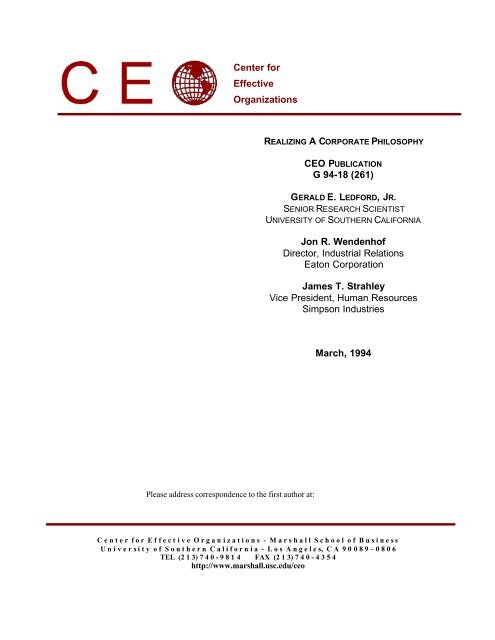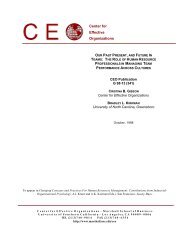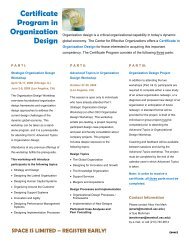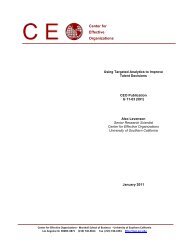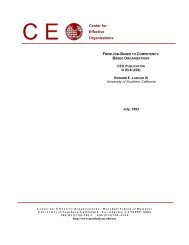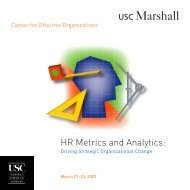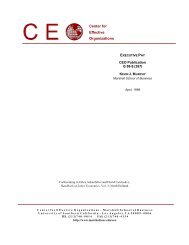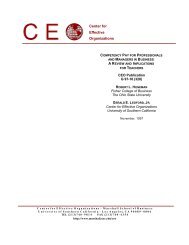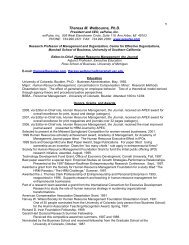Wendenhof is Corporate Director of Industrial Relations for
Wendenhof is Corporate Director of Industrial Relations for
Wendenhof is Corporate Director of Industrial Relations for
You also want an ePaper? Increase the reach of your titles
YUMPU automatically turns print PDFs into web optimized ePapers that Google loves.
REALIZING A CORPORATE PHILOSOPHYManagement scholars and practicing managers have long viewed organizations asmanifestations <strong>of</strong> the underlying values <strong>of</strong> their founders, managers, or members. Many also haveargued that corporate values are related to organizational success, and that an important task <strong>of</strong>executives <strong>is</strong> to express and help realize these values in everyday organizational life. Decadesago, <strong>for</strong> example, sociolog<strong>is</strong>t Philip Selznick argued that a mere organization becomes an enduringinstitution when it becomes infused with values that go beyond efficient per<strong>for</strong>mance. Hesuggested that value-laden institutions gain advantages over other organizations, includingemployee loyalty, adaptability to a changing environment, and enhanced prospects <strong>for</strong> survival.Selznick indicated that the most important roles <strong>of</strong> leaders are to determine key organizationalvalues and to embody them in the organization's structure.Some companies have attempted to express and rein<strong>for</strong>ce their values by stating thempublicly. Companies such as IBM, Johnson & Johnson, and Hewlett Packard have promoted aspecific statement <strong>of</strong> values <strong>for</strong> decades. Such statements have become so prevalent that six out <strong>of</strong>ten large U.S. firms have one.The statement <strong>of</strong> values might be termed a corporate philosophy, credo, v<strong>is</strong>ion, aspirations,m<strong>is</strong>sion, or principles. Some <strong>of</strong> these terms are more likely to be used in certain contexts thanothers. For example, those writing from an organizational culture perspective are more likely touse the term “philosophy,” while strateg<strong>is</strong>ts are more likely to think in terms <strong>of</strong> a “m<strong>is</strong>sion.” Incorporate practice, however, these terms are used almost interchangeably. In th<strong>is</strong> article we willspeak <strong>of</strong> corporate philosophy, but draw from literatures that use related terms as well.We first consider why corporate philosophy statements have emerged as a commonmanagement practice. We take the position that corporate philosophy statements can be beneficial,but that most do not have any evident positive effects because <strong>of</strong> flaws in the statements or in theways they are used. Next, we explore why it <strong>is</strong> possible <strong>for</strong> a firm to derive benefits fromadopting a philosophy statement. We then turn to the <strong>is</strong>sue <strong>of</strong> what corporations can do to developand implement a corporate philosophy in ways that might result in benefits to the organization.2
Finally, we examine the experience <strong>of</strong> Eaton Corporation, a company that <strong>is</strong> attempting to turn theideals expressed in its philosophy into everyday reality.The <strong>Corporate</strong> Philosophy StatementThe Emergence <strong>of</strong> the <strong>Corporate</strong> Philosophy StatementThe corporate philosophy statement did not become a popular expression <strong>of</strong> corporatevalues until the early 1980s. The turning point was two bestsellers, Peters and Waterman's InSearch <strong>of</strong> Excellence and Ouchi's Theory Z. Peters and Waterman indicated:"Every excellent company we studied <strong>is</strong> clear on what it stands <strong>for</strong>, and takes theprocess <strong>of</strong> value shaping seriously. In fact, we wonder whether it <strong>is</strong> possible to bean excellent company without clarity on values and without having the right sorts <strong>of</strong>values. . . . Clarifying the value system and breathing life into it are the greatestcontributions a leader can make."Ouchi viewed an explicit corporate philosophy as a key attribute <strong>of</strong> a clan-like "Theory Z"organization. He devoted a chapter to corporate philosophies and included the text <strong>of</strong> severalexemplars in an appendix. Ouchi argued that a philosophy <strong>is</strong> critical because it enables employeesto coordinate their activities <strong>for</strong> common purposes even in the absence <strong>of</strong> hierarchical direction.These books heralded a tremendous increase in interest among both practitioners andresearchers in the broad topic <strong>of</strong> organizational culture. Culture <strong>is</strong> typically defined as a system <strong>of</strong>shared meaning. Values--<strong>of</strong>ten tacit or even unconscious--define organizational culture at a deep,possibly unconscious level. Culture <strong>is</strong> expressed symbolically through rituals, stories, and myths,and <strong>is</strong> rein<strong>for</strong>ced by many aspects <strong>of</strong> organizational structure and functioning.Authors who write primarily <strong>for</strong> a practitioner audience have argued that a "strong" or"appropriate" organizational culture leads to improved organizational per<strong>for</strong>mance. They alsohave claimed that proactive management can help create the right kind <strong>of</strong> culture.The academic community has been more skeptical. A recent review <strong>of</strong> the literature foundlimited support <strong>for</strong> a link between organizational culture and per<strong>for</strong>mance in the little research that<strong>is</strong> available, and cast doubt on whether it <strong>is</strong> even possible to demonstrate a convincing linkage. Anumber <strong>of</strong> scholars believe that a strong organizational culture <strong>is</strong> deeply rooted in employees'views <strong>of</strong> reality, as well as a wide range <strong>of</strong> organizational practices, and <strong>is</strong> thus highly res<strong>is</strong>tant to3
change. Some contend that an organization's culture can be traced to the beliefs <strong>of</strong> its founders,and thus resembles a "genetic code" that <strong>is</strong> very difficult to rearrange. Others argue that all sizableorganizations have multiple cultures, not just one, thus vastly increasing the difficulty <strong>of</strong> managingculture.Nevertheless, academic doubts have not dampened the enthusiasm <strong>of</strong> practitioners <strong>for</strong>attempts to manage organizational culture. A character<strong>is</strong>tic early step in managing culture <strong>is</strong> thecreation <strong>of</strong> a high-level task team charged with codifying the firm's values in a <strong>for</strong>mal statement.The logic <strong>is</strong> straight<strong>for</strong>ward. If organizational values are basic to organizational culture, then theorganization's values need to be understood and actively shaped if necessary. Although manyobservers (even Peters and Waterman) are skeptical <strong>of</strong> <strong>for</strong>mal written statements <strong>of</strong> organizationalvalues, as opposed to the expression <strong>of</strong> values through myths, stories, and executive behavior,<strong>for</strong>malizing values in an <strong>of</strong>ficial philosophy statement comes naturally to <strong>for</strong>mal organizations. Sotoo does rolling out the statement throughout the organization with a fair amount <strong>of</strong> hoopla. Aconsulting mini-industry has ar<strong>is</strong>en to support all <strong>of</strong> th<strong>is</strong> activity, with the typical charge running$50,000 to $100,000 to develop a philosophy and associated communications strategy. As aresult, the corporate philosophy statement has become almost as commonplace in modern firms asthe employee handbook and the company newsletter.Why Create a <strong>Corporate</strong> Philosophy?One would hope that all <strong>of</strong> th<strong>is</strong> executive and employee attention and resources tocorporate philosophies have generated some benefit to organizations, employees, andshareholders. However, we see no reason to believe that th<strong>is</strong> happens very <strong>of</strong>ten. In ourexperience, the typical corporate philosophy statement has, at best, a negligible impact on theattitudes, beliefs, and behavior <strong>of</strong> organizational members. If employees are even aware <strong>of</strong> thephilosophy statement, they tend to regard it with indifference or cynic<strong>is</strong>m. Managers do not use it.Executives <strong>for</strong>get that it ex<strong>is</strong>ts when it <strong>is</strong> convenient to do so.4
Th<strong>is</strong> assessment <strong>is</strong> widely shared by those concerned with organizational values. JamesCollins and Jerry Porras, who have conducted the most in-depth research that <strong>is</strong> currentlyavailable on the corporate philosophies, found in their study:"[M]ost m<strong>is</strong>sion statements are terribly ineffective as a compelling, building <strong>for</strong>ce.In fact, most corporate statements we've encountered--be they called m<strong>is</strong>sion,v<strong>is</strong>ion, purpose, philosophy, credo, or the company way--are <strong>of</strong> little value. Theydon't have the intended effect. They don't grab people in the gut and motivate themto work toward a common end. They don't focus attention. They don't galvanizepeople to put <strong>for</strong>th their best ef<strong>for</strong>ts toward a compelling goal. They don't meansomething to people all up and down the organization. In fact, they are usuallynothing more than a boring stream <strong>of</strong> words."Lee Ginsburg and Neil Miller, who have conducted research and consulted on organizationalvalues, conclude:". . . <strong>for</strong> many firms, corporate values, if addressed at all, were only cited inadvert<strong>is</strong>ements, press releases, and company newsletters. Are corporate valuestaken seriously or not? Our findings indicated that they are not. Our interviews andsurveys have repeatedly shown that statements and beliefs <strong>of</strong> CEOs are not beingadhered to--the 'stated values' are not a part <strong>of</strong> the daily life <strong>of</strong> the organization."Russell Ack<strong>of</strong>f, a noted observer <strong>of</strong> management practice, has further observed:"Most corporate m<strong>is</strong>sion statements are worthless. They cons<strong>is</strong>t largely <strong>of</strong> piousplatitudes such as: 'We will hold ourselves to the highest standards <strong>of</strong>pr<strong>of</strong>essional<strong>is</strong>m and ethical behavior.' They <strong>of</strong>ten <strong>for</strong>mulate necessities asobjectives; <strong>for</strong> example, 'to achieve sufficient pr<strong>of</strong>it.' Th<strong>is</strong> <strong>is</strong> like a person sayingh<strong>is</strong> m<strong>is</strong>sion <strong>is</strong> to breathe sufficiently."These comments ra<strong>is</strong>e troubling questions. If philosophy statements do not make adifference, why do so many companies go to the trouble <strong>of</strong> developing them? Even if corporatephilosophies do not make a difference in most cases, what are the potential advantages <strong>of</strong>developing a corporate philosophy? Is it possible to develop and implement a corporatephilosophy in such a way that it increases the frequency with which managers and employees liveup to the ideals it embodies? We turn next to one <strong>of</strong> these questions.Potential Advantages <strong>of</strong> A <strong>Corporate</strong> PhilosophyAlthough the corporate philosophy statement has become extremely popular, the merits <strong>of</strong>developing such a statement have not received careful scrutiny. There have been scores <strong>of</strong> articles5
about philosophy statements, but there has been very little research on the topic. Th<strong>is</strong> makes anyconclusions speculative. Three broad purposes <strong>of</strong> corporate philosophy statements appear in theliterature. These include guiding behavior and dec<strong>is</strong>ion making; <strong>of</strong>fering meaning to employeesthrough the expression or enhancement <strong>of</strong> organizational culture; and inspiring commitment to theorganization, leading to higher per<strong>for</strong>mance.A corporate philosophy statement can be used to guide behavior and dec<strong>is</strong>ions. Values,which a philosophy statement expresses, by their nature define what courses <strong>of</strong> action andoutcomes "should be." Thus, the philosophy statement can help direct employee attention in somedirections and not others. Johnson & Johnson provides a frequently cited example <strong>of</strong> the use <strong>of</strong> acorporate philosophy statement in dec<strong>is</strong>ion making. Based partly on a review if its <strong>Corporate</strong>Credo, the company responded to the infamous po<strong>is</strong>onings <strong>of</strong> Extra Strength Tylenol bywithdrawing the product from stores throughout the country, not just in the region where thepo<strong>is</strong>onings occurred. Ouchi provides examples <strong>of</strong> specific employees who made use <strong>of</strong> theircompany's written philosophy in deciding what action to take. For example, a marketing managerused the philosophy to help set a fair pricing strategy <strong>for</strong> a new product. At Levi Strauss,managers have used the firm's Aspirations Statement to help make dec<strong>is</strong>ions about work designand the use <strong>of</strong> in<strong>for</strong>mation technology that links the company and suppliers. It has also ledmanagement to avoid prom<strong>is</strong>es <strong>of</strong> secure employment that might later have to be broken.Many people are skeptical about whether something so broad as a corporate philosophycould serve as a real guide to behavior and dec<strong>is</strong>ion making. Th<strong>is</strong> skeptic<strong>is</strong>m <strong>is</strong> justified if weexpect the philosophy to play too specific a role. The values <strong>of</strong> a philosophy tend to be generalrather than specific. Indeed, an extremely detailed statement <strong>of</strong> values would not be any morememorable or emotionally compelling than a book <strong>of</strong> standard operating procedures.Nevertheless, a philosophy can <strong>of</strong>fer broad guidance.A second potential advantage <strong>of</strong> a corporate philosophy <strong>is</strong> in expressing organizationalculture, thus helping employees to interpret ambiguous stimuli in ways that make sense. Ambiguity<strong>is</strong> everywhere in organizations. There <strong>of</strong>ten are no obvious answers to such basic questions as, <strong>is</strong>6
my unit per<strong>for</strong>ming well? Am I paid fairly <strong>for</strong> my contribution to the organization? Are differentemployee groups in the organization treated fairly by management? Is the company pursuing theright strategy? Research on organizational culture has cons<strong>is</strong>tently emphasized that culture helpsemployees interpret their social reality in ways that permit them to answer such questions. Sensemaking <strong>is</strong> perhaps the most important attribute <strong>of</strong> organizational cultures. Organizational cultureshelp employees to arrive at shared goals and expectations, to understand how their individualroles fit within a larger picture, to maintain norms <strong>of</strong> acceptable conduct, and to derive cons<strong>is</strong>tentinterpretations <strong>of</strong> the acts <strong>of</strong> managers, peers, and customers.We should not expect that a corporate philosophy <strong>is</strong> powerful enough, by itself, to fullyexpress an organizational culture or to replace other expressions <strong>of</strong> the culture. However, aphilosophy statement can <strong>of</strong>fer one clear, compelling statement <strong>of</strong> the corporate v<strong>is</strong>ion. It tellsemployees and prospective employees what the organization stands <strong>for</strong>, and it can help set anemotional tone <strong>for</strong> the culture. Th<strong>is</strong> use <strong>of</strong> philosophy statements <strong>is</strong> cons<strong>is</strong>tent with the purposes <strong>of</strong>philosophies found in a survey <strong>of</strong> large Brit<strong>is</strong>h firms.It <strong>is</strong> interesting that corporate philosophy statements manifest not only organizationalculture, but national cultures as well. Th<strong>is</strong> <strong>is</strong> one reason <strong>for</strong> considerable overlap in the content <strong>of</strong>the philosophies <strong>of</strong> different companies from the same society. A recent study indicates thatEuropean, American, and Japanese companies tend to produce different types <strong>of</strong> philosophystatements that reflect national cultures. Western philosophy statements, <strong>for</strong> example, tend to bemuch more explicit and in<strong>for</strong>mative and tend to emphasize the role <strong>of</strong> the corporation in relation toexternal stakeholders, such as customers and the general public. Japanese philosophy statementstend to be internally focused and more emotional in tone, and tend to emphasize internalcooperation and harmony.Even a relatively specific statement <strong>of</strong> corporate philosophy can evolve in meaning as theorganization changes over time and as the national culture evolves. Consultant and author MichaelMaccoby once compared a value statement that he helped develop to the Declaration <strong>of</strong>Independence. Th<strong>is</strong> <strong>is</strong> an intriguing compar<strong>is</strong>on. For example, the Declaration's famous statement7
that "all men are created equal" captured the ideal <strong>of</strong> a society that, at the time, allowed onlywhite, male property holders to vote. Each generation has redefined equality, and struggles overits meaning have been fierce and sometimes bloody. The phrase haunted the conscience <strong>of</strong> thenation as the franch<strong>is</strong>e was extended first to those who did not own property, then to <strong>for</strong>mer slaves,and finally to women. Contemporary extensions <strong>of</strong> the concept <strong>of</strong> equality and equal protection gowell beyond the v<strong>is</strong>ion <strong>of</strong> the nation's Founding Fathers, as some <strong>for</strong>m <strong>of</strong> equal protection has beenextended to such groups such as children, illegal aliens, and the d<strong>is</strong>abled. Similarly,interpretations <strong>of</strong> the values expressed in a corporate philosophy statement can be expected toevolve over time.A third potential advantage <strong>of</strong> a philosophy statement <strong>is</strong> that it may contribute toorganizational per<strong>for</strong>mance by inspiring employee motivation or feelings <strong>of</strong> commitment to theorganization. If the l<strong>of</strong>ty ideals expressed in the philosophy statement resonate with the privatevalues <strong>of</strong> employees, then employees may be more willing to view the meeting <strong>of</strong> organizationalends as cons<strong>is</strong>tent with their own desires. Thus, Collins and Porras argue that the statement should"be able to grab the 'soul' <strong>of</strong> each organizational member". The philosophy statement can bev<strong>is</strong>ionary. That <strong>is</strong>, it can express what the organization w<strong>is</strong>hes to be rather than what it presently<strong>is</strong>. Ack<strong>of</strong>f indicates that "A m<strong>is</strong>sion should play the same role in a company that the Holy Graildid in the Crusades. It does not have to appear feasible: it only has to appear desirable." Thephilosophy statement does not necessarily have to move mountains to make a cumulative differencein corporate per<strong>for</strong>mance. If individual employees become just a little more dedicated to servingtheir customers, exert just a bit more ef<strong>for</strong>t to meeting important per<strong>for</strong>mance goals, and care just alittle more about their work, the statement may <strong>of</strong>fer a positive return on the investment needed toproduce it. Some authorities claim that high per<strong>for</strong>mance, high commitment work systems derivein part from clear values, and that a philosophy statement <strong>is</strong> a key step in designing such systems.Perhaps the most eloquent executive on the subject <strong>of</strong> corporate philosophies <strong>is</strong> RobertHaas, Chairman and CEO <strong>of</strong> Levi Strauss. In a Harvard Business Review interview, he said:8
What we've learned <strong>is</strong> that the s<strong>of</strong>t stuff and the hard stuff are becomingincreasingly intertwined. A company's values--what it stands <strong>for</strong>, what its peoplebelieve in--are crucial to its competitive success. Indeed, values drive thebusiness. . . In a more volatile and dynamic business environment, the controls haveto be more conceptual. They can't be human any more: Bob Haas telling peoplewhat to do. It's the ideas <strong>of</strong> a business that are controlling, not some manager withauthority.It <strong>is</strong> interesting in th<strong>is</strong> regard that one study found that the firms that specified a philosophyin the corporate m<strong>is</strong>sion statement were more pr<strong>of</strong>itable than those that did not. Results such asthese need to be interpreted cautiously, because there are many possible causes <strong>of</strong> such anassociation. For example, more pr<strong>of</strong>itable firms have available to them more resources <strong>for</strong>developing pol<strong>is</strong>hed philosophy statements. Nevertheless, the results are provocative, andcons<strong>is</strong>tent with the arguments made by proponents <strong>of</strong> philosophy statements.Is There a Downside to a <strong>Corporate</strong> Philosophy?With such advantages to adopting a corporate philosophy, should every company have one?We believe that a philosophy may not be a positive or even a neutral <strong>for</strong>ce in all cases. A poorlyenacted philosophy <strong>is</strong> likely to breed cynic<strong>is</strong>m or apathy. The more beautiful the prose and themore desirable the v<strong>is</strong>ion, the more apparent will be any d<strong>is</strong>crepancy between the dream andreality. As a result, a philosophy statement by itself <strong>is</strong> not likely to have any positive effect, andmay even demoralize employees rather than inspire them if they see it as empty words. Inaddition, a philosophy that becomes too rigid may become a justification <strong>for</strong> failing to grapplewith new corporate challenges. Th<strong>is</strong> <strong>is</strong> the obverse side <strong>of</strong> the culture coin. A strong culture,fostered in part by a compelling organizational philosophy, may channel perceptions in ways thatencourage common understanding--or may make employees blind to changing realities. It <strong>is</strong>interesting that IBM, a company that has per<strong>for</strong>med poorly because it failed to adapt to a changingenvironment, once was frequently and favorably cited as a company with a strong corporatephilosophy. Its philosophy, penned by founder Thomas Watson Sr., became a justification <strong>for</strong>stagnation in recent years. Its emphas<strong>is</strong> on the individual encouraged IBM to ignore theimportance <strong>of</strong> teams to a high technology firm, and the emphas<strong>is</strong> on "excellence" in everythingbecame an excuse <strong>for</strong> bureaucratic excess at every turn.9
Means <strong>of</strong> Realizing a <strong>Corporate</strong> PhilosophyClearly, not every corporation that adopts a <strong>for</strong>mal philosophy realizes benefits. But if weassume that it <strong>is</strong> possible to gain value in the expression and use <strong>of</strong> a corporate philosophy, we areleft with another important question. How <strong>is</strong> it possible to make the corporate philosophy real--that <strong>is</strong>, something more than a set <strong>of</strong> empty platitudes? How <strong>is</strong> it possible to develop the "right"philosophy--that <strong>is</strong>, one that reflects the values, business strategy, core competencies, andpractices the firm needs to succeed? There are a number <strong>of</strong> possible answers, which aresummarized in Figure 2.First, the wording <strong>of</strong> the statement may affect how it <strong>is</strong> used and whether employees andmanagers take it seriously. Most writing on the topic <strong>of</strong> corporate philosophies has focused on th<strong>is</strong><strong>is</strong>sue. Some <strong>of</strong> the resulting advice <strong>is</strong> useful. We find it hard to argue with the commonplace call<strong>for</strong> compelling, vivid prose. Returning to our example <strong>of</strong> the Declaration <strong>of</strong> Independence, thestatement that "We hold these truths to be self-evident, that all men are created equal . . ." <strong>is</strong> simplymore powerful and memorable than "we believe in fairness." In addition, if no one can d<strong>is</strong>agreewith the statement, it probably <strong>is</strong> too bland to be <strong>of</strong> value. If the statement <strong>is</strong> too long and complex,it will not be remembered. Stan Dav<strong>is</strong> argues <strong>for</strong> a statement that includes no more than fourguiding beliefs. He makes the arresting argument that the Ten Commandments are better knownthan any corporate values, yet few people can recite many <strong>of</strong> them.Although the statement itself probably matters, we believe that most observersoverestimate the importance <strong>of</strong> the prose. Few employees or managers make a hobby <strong>of</strong> literarycritic<strong>is</strong>m. They are unlikely to scrutinize the text. More important, there are more importantfactors governing their behavior other than the specific words in a philosophy statement.A second means <strong>of</strong> realizing a philosophy <strong>is</strong> use <strong>of</strong> an effective process <strong>for</strong> thedevelopment and communication <strong>of</strong> the philosophy throughout the company. Companies aredevoting extensive attention to th<strong>is</strong> step. Much has been written about it. As a result,communication plans are becoming increasingly soph<strong>is</strong>ticated. Media used to communicate thephilosophy statement range from pr<strong>of</strong>essional videos to small group d<strong>is</strong>cussion meetings to wallet-10
sized cards emblazoned with the statement. It <strong>is</strong> common to assign th<strong>is</strong> step to a special crossleveltask <strong>for</strong>ce, possibly with the ass<strong>is</strong>tance <strong>of</strong> a consulting firm that specializes in corporatephilosophies. Such groups are useful <strong>for</strong> collecting a variety <strong>of</strong> perspectives on corporate valuesand <strong>for</strong> developing ideas about communication strategies. However, it may be that in<strong>of</strong>fensive andunexciting philosophy statements are one outgrowth <strong>of</strong> the use <strong>of</strong> such task <strong>for</strong>ces. It <strong>is</strong> interestingto note here that company founders (such as IBM's Watson) rather than quasi-participative taskteams penned many <strong>of</strong> the best-known and most memorable corporate philosophies.The development process may help determine how seriously the philosophy statement <strong>is</strong>viewed in the organization. A good development process may ra<strong>is</strong>e employee awareness <strong>of</strong> thephilosophy and may increase feelings <strong>of</strong> ownership <strong>for</strong> it. However, we see development andcommunication processes as important but insufficient <strong>for</strong> the realization <strong>of</strong> a corporatephilosophy. The key problems rarely lie in employee understanding and agreement with thephilosophy. Rather, the key problems lie in aligning behavior, policies and practices with the finesentiments expressed in the philosophy. If a public relations campaign heightens employeeawareness <strong>of</strong> the gap between corporate rhetoric and reality, it may actually weaken the impact <strong>of</strong>the philosophy. Thus, the benefits <strong>of</strong> a good development and communication process may beshort term only unless the organization itself changes in ways that are cons<strong>is</strong>tent with thephilosophy.Th<strong>is</strong> suggests a third means <strong>of</strong> realizing a corporate philosophy: wed it to every majorhuman resource system that governs the behavior <strong>of</strong> organizational members. Th<strong>is</strong> weavesphilosophical principles into the fabric <strong>of</strong> daily organizational life. It requires translating generalvalue statements into specific policies. In our view, th<strong>is</strong> <strong>is</strong> the most important strategy <strong>for</strong>realizing a corporate philosophy.Some examples illustrate how companies realize values through a focus on systems.Reward systems are probably the most powerful means <strong>of</strong> influencing the realization <strong>of</strong> aphilosophy. Over the long term, employees tend to do what they are rewarded <strong>for</strong> doing and stopdoing what they are not rewarded <strong>for</strong> doing. For example, 3M and Rubbermaid place a high value11
on innovation and are among the most innovative organizations in the U.S. Th<strong>is</strong> <strong>is</strong> expressed in areward system that requires managers to meet high targets <strong>for</strong> the percentage <strong>of</strong> their sales that arederived from products introduced within the last five years. Similarly, firms that place a value onentrepreneurial behavior need to place pay at r<strong>is</strong>k and provide high rewards <strong>for</strong> successful r<strong>is</strong>ktaking.Conversely, organizations that value stability and long-term ef<strong>for</strong>t (such as universities andR&D labs) tend to <strong>of</strong>fer more job security than most.Per<strong>for</strong>mance appra<strong>is</strong>al also can be based on behaviors that are relevant to the corporatephilosophy. AlliedSignal, <strong>for</strong> example, currently assesses the per<strong>for</strong>mance <strong>of</strong> every manager onbehaviors that are associated with a statement <strong>of</strong> corporate values. Levi Strauss bases one-third <strong>of</strong>the per<strong>for</strong>mance appra<strong>is</strong>al rating on behavior that <strong>is</strong> cons<strong>is</strong>tent with the corporate "AspirationsStatement." Per<strong>for</strong>mance appra<strong>is</strong>als also can be used to recognize more specific elements <strong>of</strong> acorporate philosophy or value statement. General Mills values community involvement, andvolunteer activities are explicitly recognized in per<strong>for</strong>mance appra<strong>is</strong>als. Ultimately, careersuccess must be based on corporate values if those values are to be taken seriously.Training practices also need to reflect the philosophy. Training about the philosophy itselfand how it relates to the behavior <strong>of</strong> employees may be needed. The overall amount <strong>of</strong> trainingprovided by the firm and whether the firm rewards employee development provide important cuesabout how seriously employees should take value statements about the development <strong>of</strong> employeesskills and abilities. Th<strong>is</strong> <strong>is</strong> especially true <strong>of</strong> firms that have a philosophy espousing a value onemployee development. For example, the Sun Company's l<strong>of</strong>ty statement that "We believe humandevelopment to be the worthiest <strong>of</strong> goals <strong>of</strong> civilization . . ." commits the company to a highinvestment in training and development.Special training may need to be provided to managers to help them learn about thephilosophy and how to manage in a way that <strong>is</strong> cons<strong>is</strong>tent with it. The Minneapol<strong>is</strong> Star Tribune <strong>is</strong>attempting to become a "principles-driven, not a policy-driven, business." The newspaper hasdeveloped an innovative management training ef<strong>for</strong>t called "More Power to Us." It <strong>is</strong> intended toshow managers how relying on core values will help the paper realize its strategy, and in turn to12
meet its purpose. Its purpose <strong>is</strong> "to enrich the shared life <strong>of</strong> the community by being the area'sleading provider <strong>of</strong> in<strong>for</strong>mation that people value." The document and training help managersunderstand how the paper's restructuring into work teams that have substantial dec<strong>is</strong>ion makingpower has increased per<strong>for</strong>mance. They also help managers understand the implications <strong>of</strong> thesechanges <strong>for</strong> their own roles and behavior.The hiring process also can reflect the philosophy. The nature <strong>of</strong> the process should reflectany values concerning openness, trust, and fairness. Whether employees are given a real<strong>is</strong>ticpicture <strong>of</strong> the plusses and minuses <strong>of</strong> the job and working <strong>for</strong> the organization will govern earlyemployee impressions <strong>of</strong> whether the organization trusts them and <strong>is</strong> trustworthy. An explicit rolecan be given to the corporate philosophy as well. Johnson & Johnson tells all job applicants aboutits Credo, and all new employees receive a copy and an explanation <strong>of</strong> the document. Th<strong>is</strong>appears to be a common practice among Japanese companies. The philosophy can also be used todetermine what traits should be sought in potential employees. Southwest Airlines believes "workshould be fun . . . it can be play . . . enjoy it." As a result, the company attempts to hire employeeswho have a sense <strong>of</strong> humor--as Southwest passengers long ago d<strong>is</strong>covered.The corporate philosophy should be reflected in other systems as well. Examples includethe design <strong>of</strong> work (<strong>for</strong> example, the role given to teams reflects values around teamwork),organization structure (<strong>for</strong> example, the number <strong>of</strong> management layers reflects values aroundemployee empowerment), and labor relations (<strong>for</strong> example, the corporate stance toward unionsreflects various values).A final means <strong>of</strong> realizing a corporate philosophy <strong>is</strong> a process <strong>of</strong> ongoing affirmation andrenewal <strong>of</strong> the philosophy. All <strong>of</strong> the other means can be used, and yet not be enough. Thestatement may be well written, the philosophy may be communicated well, and variousorganizational systems may rein<strong>for</strong>ce it. Yet, a process <strong>is</strong> still needed to continually nuture interestin and use <strong>of</strong> the philosophy. In some explicit way, the firm actively engage employees in anexplicit reconsideration <strong>of</strong> the meaning <strong>of</strong> the philosophy and whether it <strong>is</strong> being lived in the firm.Th<strong>is</strong> approach has received virtually no attention in the prior literature. One company's attempt to13
use th<strong>is</strong> approach will be the focus <strong>of</strong> the remainder <strong>of</strong> th<strong>is</strong> paper. We will d<strong>is</strong>cuss an innovativeplant v<strong>is</strong>it process used by the Eaton Corporation <strong>for</strong> affirmation and renewal <strong>of</strong> its philosophy.The Eaton Corporation Philosophy Plant V<strong>is</strong>it ProcessEaton Corporation <strong>is</strong> a Cleveland-based manufacturer <strong>of</strong> motor vehicle components (suchas valves, brakes, and axles) and controls <strong>for</strong> appliances, vehicles, and industrial equipment. Withover $4.4 billion in sales, the company ranked as the 115st largest firm in the 1994 Fortune 500l<strong>is</strong>tings. After recent acqu<strong>is</strong>itions, it now has 50,000 employees and 146 manufacturing plants.Eaton <strong>is</strong> a global firm, with over 50 plants in Europe, Asia, Australia, and Latin America. Despiteits size, the company <strong>is</strong> largely unknown to the general public because it sells few products <strong>for</strong> themass market. However, the company <strong>is</strong> well known to investors and others in the businesscommunity due to its long track record <strong>of</strong> growth and pr<strong>of</strong>itability. For example, Eaton ranked128th among Fortune 500 firms in total return to investors during the previous year. For a number<strong>of</strong> years, Eaton has ranked first, second, or third among motor vehicle industry firms in Fortune'sannual rankings <strong>of</strong> most admired companies.Origins <strong>of</strong> The Eaton PhilosophyThe Eaton Philosophy: Excellence Through People arose from the company's experienceswith innovative employee relations ef<strong>for</strong>ts. The beginning was in the valve business in 1969. Atthe time, Eaton built valves at a large plant in Battle Creek, Michigan that had a h<strong>is</strong>tory <strong>of</strong>contentious union-management relations. Eaton had the opportunity to obtain new valve businessfrom Ford if it would build a second plant, insuring a stable supply <strong>of</strong> valves. Eaton built a"greenfield" plant in Kearney, Nebraska.The Kearney plant was designated as a "new philosophy" plant. Th<strong>is</strong> meant that the plantwas managed in a way that increased mutual respect and trust between factory and managementemployees. Status differences between management and non-management were minimal; therewere no time clocks, buzzers, or wh<strong>is</strong>tles. Management encouraged employees to contribute ideas<strong>for</strong> improvement. The company paid <strong>for</strong> casual absences <strong>of</strong> all employees, yet the absentee<strong>is</strong>mrate was only 1%. By current standards, the human resource practices <strong>of</strong> the plant were not14
evolutionary. The plant did not use self-managed work teams, skill based pay, gainsharing, orother innovations that are common today in new high involvement plants. Nevertheless, thechanges were radical in Eaton, and the differences in employee morale and plant per<strong>for</strong>mancebetween the Battle Creek and Kearney plants were stunning. The Kearney plant achieved 25 to 30percent greater productivity using the same production technology. Human resource practices atthe plant have continued to evolve, and the plant remains to th<strong>is</strong> day one <strong>of</strong> the most efficient in itsindustry. Eaton managers recognized and appreciated the success at Kearney. As Eaton grew andbuilt new plants, every new plant was built on the Kearney "new philosophy" model.The early 1980s brought hard economic times and fierce domestic and internationalcompetition to Eaton's core businesses. Eaton, like other companies, began looking <strong>for</strong> everypossible source <strong>of</strong> competitive advantage as it faced a tougher and more uncertain environment. In1983, as the national economy began to emerge from recession, Eaton's then-CEO E. M. de Windtasked the human resource function to review the new philosophy plants. The <strong>Director</strong> <strong>of</strong> <strong>Industrial</strong><strong>Relations</strong>, who subsequently led or organized all major corporate initiatives related to the EatonPhilosophy, led the review team. The purpose <strong>of</strong> the review was to learn whether the plants'management style survived during the recession and how that management style was related toper<strong>for</strong>mance. The investigators concluded that although some new plants had struggled, on theywhole they had continued to maintain their innovative management style. The level <strong>of</strong> employeeinvolvement, communication, and reward innovation had deepened over the years in most <strong>of</strong> theplants. Most important, those plants that maintained their innovative management style showedbetter operating per<strong>for</strong>mance than those that did not.The Human Resources group presented their report and suggested a course <strong>of</strong> action to Mr.de Windt. They proposed capturing the central themes in the new philosophy plants and diffusingthe new management philosophy throughout the company. The executive group took these findingsseriously, and the Chief Executive Officer resolved to spread the new philosophy throughoutEaton. In 1984, senior management comm<strong>is</strong>sioned a task <strong>for</strong>ce that included representatives <strong>of</strong> thecorporate headquarters, each <strong>of</strong> the four main business groups, and international operations. The15
task <strong>for</strong>ce was charged with drafting the "Eaton Philosophy: Excellence through People," whichwould capture the best principles <strong>of</strong> the new plants and articulate them in a <strong>for</strong>mal statement.Figure 3 d<strong>is</strong>plays the philosophy statement. The philosophy was introduced to virtually every U.S.employee <strong>of</strong> Eaton in 1985, and to employees <strong>of</strong> international operations in succeeding years.Selected management representatives received two and a half days <strong>of</strong> training and orientation,which equipped them to per<strong>for</strong>m management orientations in their own organizations. Allemployees participated in meetings that included a videotape about the philosophy, and allreceived a brochure detailing the philosophy. To assess the company's progress toward practicingthe philosophy, the human resource function comm<strong>is</strong>sioned a survey <strong>of</strong> Eaton employees thatprovided data about topics relevant to the philosophy.Until th<strong>is</strong> point, the process by which the Eaton Philosophy was developed and rolled outresembled that used by many American firms. Most U.S. companies would be com<strong>for</strong>table withthe Eaton philosophy statement. While Eaton was an early adopter, it was not the first to developa corporate philosophy. The main difference between the Eaton Philosophy and the statements <strong>of</strong>many other firms was its direct origins in the internal experiences <strong>of</strong> the company. The financialsuccess <strong>of</strong> the "new philosophy" plants was critical. The company's experience showed that newways <strong>of</strong> managing people contributed to business per<strong>for</strong>mance. The Eaton philosophy was notadopted because corporate philosophies were in fashion, and it was not the product <strong>of</strong> a consultingor public relations firm.Eaton Philosophy Plant V<strong>is</strong>it ProcessIn 1988, Eaton made a significant departure from conventional practice. The companyadopted an innovative process <strong>for</strong> monitoring the implementation <strong>of</strong> the philosophy throughout thefirm. Th<strong>is</strong> process, termed the Eaton Philosophy Plant V<strong>is</strong>it Process, now has been used withgreat success <strong>for</strong> six years. The process <strong>is</strong> interesting in part because it engages employees at alllevels in an active inquiry into progress in realizing the Eaton Philosophy. The process hasinvolved scores <strong>of</strong> v<strong>is</strong>its to Eaton plants in the U.S. and <strong>for</strong>eign countries, and has directly16
involved thousands <strong>of</strong> employees. The remainder <strong>of</strong> th<strong>is</strong> article will explore the nature <strong>of</strong> th<strong>is</strong>process and how it has evolved over time.The company's senior executive group was concerned that the Eaton philosophy mightbecome a one-time event, not a way <strong>of</strong> life. They charged the human resource function withdeveloping some means <strong>of</strong> making the realization <strong>of</strong> the philosophy an ongoing process. Theinitial design called <strong>for</strong> corporate teams to v<strong>is</strong>it a set <strong>of</strong> plants to examine use <strong>of</strong> the philosophy.Th<strong>is</strong> was done in 1988, but the process proved unsat<strong>is</strong>fying. The principles <strong>of</strong> the philosophy, bytheir nature, were difficult <strong>for</strong> employees at any level to d<strong>is</strong>agree with, and questions about thephilosophy and its use tended to produce "motherhood and apple pie" statements. With consultinghelp from the Center <strong>for</strong> Effective Organizations <strong>of</strong> the University <strong>of</strong> Southern Cali<strong>for</strong>nia, the<strong>Director</strong> <strong>of</strong> <strong>Industrial</strong> <strong>Relations</strong> dev<strong>is</strong>ed a new approach <strong>for</strong> 1989. The same approach has beenused each year since then, and it <strong>is</strong> a ritual that <strong>is</strong> becoming rooted in the culture <strong>of</strong> the company.The Annual Plant V<strong>is</strong>it CycleThe cycle <strong>of</strong> activity begins early in the year with the identification <strong>of</strong> v<strong>is</strong>it sites and v<strong>is</strong>itteam members. In 1993, <strong>for</strong> example, 30 team members v<strong>is</strong>ited 18 plants, or about one-fifth <strong>of</strong> theEaton plants then located in North America. Executives <strong>of</strong> the company's major business groupsand the corporate Human Resources staff nominate most <strong>of</strong> the v<strong>is</strong>it sites, although in some casesplant managers request that their location be included. V<strong>is</strong>it team members come from every level<strong>of</strong> management, every function, and every geographic area. They represent relatively young, highpotential managers and some more senior executives who hold critical positions.The extensive use <strong>of</strong> high potential managers <strong>is</strong> a key to the success <strong>of</strong> the process. Theuse <strong>of</strong> high potential managers in the v<strong>is</strong>it teams demonstrates in a tangible way the seriousnesswith which senior executives view the Eaton Philosophy and the v<strong>is</strong>it process. More subtly,inclusion in the v<strong>is</strong>it teams <strong>of</strong>fers public confirmation that the manager <strong>is</strong> considered to have highpotential, so members <strong>of</strong> the v<strong>is</strong>it teams tend see their assignment more as a reward than a burden.Over 150 managers have been included in the v<strong>is</strong>it teams so far. Participation in the program <strong>is</strong>becoming an accepted rite <strong>of</strong> passage <strong>for</strong> managers on the way up the corporate ladder. V<strong>is</strong>it team17
members have included some who are now among the most senior executives in the corporation,and it <strong>is</strong> likely that one day the Chairman <strong>of</strong> the company will have been a v<strong>is</strong>it team member. Thev<strong>is</strong>it process serves as an excellent management development tool. Managers develop importantcontacts and friendships through their involvement in the v<strong>is</strong>it teams. Since they only v<strong>is</strong>it sitesthat are in business groups other than their own, team members gain broader first-hand exposure tothe company. They usually find ideas <strong>for</strong> changes that they can take back to their home plant.Finally, the activity serves as an opportunity <strong>for</strong> team members to reflect on the values <strong>of</strong> thecompany and how the values are expressed in daily practice.Early in the year, human resource managers lead two days <strong>of</strong> training <strong>for</strong> v<strong>is</strong>it teammembers. A top executive <strong>of</strong> the company (Vice President or above) typically stops in to expresssupport <strong>for</strong> the process and compliment the attendees <strong>for</strong> their selection to the v<strong>is</strong>it teams. Thehuman resource managers summarize the h<strong>is</strong>tory <strong>of</strong> the Eaton Philosophy and the plant v<strong>is</strong>itprocess, and describe the role <strong>of</strong> v<strong>is</strong>it team members. Most <strong>of</strong> the session <strong>is</strong> devoted to training inactive l<strong>is</strong>tening and conducting effective interviews. The training helps them identify theirstrengths and weaknesses as interviewers, and avoid possible pitfalls <strong>of</strong> the v<strong>is</strong>it team process.Plant v<strong>is</strong>its are scheduled throughout the year. The v<strong>is</strong>it team <strong>for</strong> any given plant typicallyincludes four members from the interviewer pool and two corporate human resource managersexperienced in the v<strong>is</strong>it process. The v<strong>is</strong>it process begins with a dinner hosted by the local topmanagement group. Th<strong>is</strong> social event tends to reduce the threat that local managers mightotherw<strong>is</strong>e feel from having outsiders conduct confidential interviews with their employees. Thenext day <strong>is</strong> spent receiving a brief tour <strong>of</strong> the site and conducting interviews. The v<strong>is</strong>it teamdivides into two subgroups, each <strong>of</strong> which conducts a series <strong>of</strong> group interviews. Employees arerandomly selected from the plant population and asked to participate. The v<strong>is</strong>it team interviewsthe top management team and small groups <strong>of</strong> randomly chosen factory employees, superv<strong>is</strong>ors,and <strong>of</strong>fice employees. Employees are interviewed on all shifts. Different hierarchical levels arenot mixed in the interview groups. Interviewees are assured <strong>of</strong> confidentiality. The v<strong>is</strong>it teaminterviews a total <strong>of</strong> about 70 employees and managers.18
The interview questions do not ask employees <strong>for</strong> their opinion <strong>of</strong> the Eaton Philosophy,and do not ask directly <strong>for</strong> a rating <strong>of</strong> how well the plant <strong>is</strong> doing on specific prov<strong>is</strong>ions <strong>of</strong> thephilosophy. Rather, the questions ask employees to describe real situations within the plant thatmight represent illustrations <strong>of</strong> each <strong>of</strong> the eight principles <strong>of</strong> the philosophy in action. Forexample, rather than asking how much employees are involved in dec<strong>is</strong>ion making, they might beasked to describe the last manufacturing process change. The v<strong>is</strong>it team infers the level <strong>of</strong>employee involvement in organizational changes from the d<strong>is</strong>cussion.On the final day, the entire v<strong>is</strong>it team organizes a presentation, spending a half-daysummarizing what they have heard and d<strong>is</strong>cussing their findings with the plant management team.The session captures the diversity <strong>of</strong> experiences the team has heard about, and indicates <strong>is</strong>suesthat were especially salient. The feedback <strong>is</strong> intended to be fair but not sugar-coated. Thefeedback sometimes surpr<strong>is</strong>es or unnerves the plant manager or top management team, and onoccasion the feedback session <strong>is</strong> an emotionally wrenching experience. In one plant, <strong>for</strong> example,there was a stark difference in the climate <strong>of</strong> two parts <strong>of</strong> the plant, which employees called"America" and "Russia." Th<strong>is</strong> was a traumatic d<strong>is</strong>covery <strong>for</strong> the top management team, which hadgreatly underestimated the differences in management style between the two areas. Throughout thefeedback process, the v<strong>is</strong>it team avoids action recommendations. The focus <strong>is</strong> on understandingand problem d<strong>is</strong>covery. Th<strong>is</strong> <strong>for</strong>ces local management to assume responsibility <strong>for</strong> a finalinterpretation <strong>of</strong> the feedback data and <strong>for</strong> making any changes, and avoids asking the v<strong>is</strong>it team todo more than <strong>is</strong> real<strong>is</strong>tic in a short v<strong>is</strong>it. The v<strong>is</strong>it team follows up with a written report to plantmanagement that summarizes their findings.The plant management team <strong>is</strong> required to provide feedback to employees about theinterview results, and <strong>is</strong> asked to determine whether any problem areas require further attention.However, no one follows up to insure that local management develops or carries out action plans.Confidentiality <strong>of</strong> feedback from those above the plant level <strong>is</strong> absolute. Thus, action depends onlocal management initiative. Th<strong>is</strong> <strong>is</strong> a striking departure from standard procedure in Eaton.19
After the v<strong>is</strong>it team completes the entire round <strong>of</strong> plant v<strong>is</strong>its, a wrap-up meeting <strong>is</strong> held <strong>for</strong>all the v<strong>is</strong>it team members and a representative <strong>of</strong> each v<strong>is</strong>ited plant. In the spirit <strong>of</strong> continuousimprovement, the session reviews highlights, shortcomings, accompl<strong>is</strong>hments, and problemsexperienced during the plant v<strong>is</strong>its. The group then fashions a set <strong>of</strong> conclusions about the status<strong>of</strong> the Eaton Philosophy and <strong>is</strong>sues that senior executives may need to address to further realize thephilosophy in daily life. The corporate human resource department then captures these findings ina <strong>for</strong>mal report to the senior executive team. Th<strong>is</strong> <strong>is</strong> the only reporting that <strong>is</strong> made to higher-levelmanagement, and it maintains confidentiality <strong>for</strong> specific sites. The year-end meeting <strong>is</strong> the only<strong>for</strong>mal follow-up to d<strong>is</strong>cuss the impact <strong>of</strong> the plant v<strong>is</strong>it process. Plants are rev<strong>is</strong>ited after a fewyears, which af<strong>for</strong>ds the v<strong>is</strong>it team a general perspective on whether the plant has made changesover the years. However, there obviously <strong>is</strong> no tight top-down control over whether the plantstake the process seriously. It remains the responsibility <strong>of</strong> the plant management team to act on thev<strong>is</strong>it team's findings.One very clear finding from the wrap-up meetings <strong>is</strong> that the self-help approach toaddressing problems related to the Eaton Philosophy does in fact lead to change at the plant level.On average, the v<strong>is</strong>ited plants adopt two to three significant changes as a result <strong>of</strong> the v<strong>is</strong>itprocess. Typical changes include new training programs, new mechan<strong>is</strong>ms <strong>for</strong> communicatingbusiness in<strong>for</strong>mation, and enhancements to employee involvement ef<strong>for</strong>ts. One <strong>of</strong> the mostdramatic changes was at an Eaton location in a deteriorating urban neighborhood. The most salient<strong>is</strong>sue in the minds <strong>of</strong> employees was personal safety, an <strong>is</strong>sue that came up repeatedly in theinterviews even though there was no question that specifically addressed th<strong>is</strong> topic. A number <strong>of</strong>crimes had taken place in the parking lot and near the facility. Local management had notunderstood the depth <strong>of</strong> employee fear about crime be<strong>for</strong>e the interview feedback. As a directresult <strong>of</strong> the feedback, management <strong>for</strong>med employee task <strong>for</strong>ces and committes to define the <strong>is</strong>suesand develop action plans. Th<strong>is</strong> led to a number <strong>of</strong> steps that included revamping its securitysystems, improving parking lot security, and creating a hot line to respond to rumors and providein<strong>for</strong>mation about crimes. Management also worked with the local community, establ<strong>is</strong>hing a20
neighborhood block watch program that equipped members with two-way radios that permittedthem to contact Eaton security personnel, who could immediately contact police. Crime in theneighborhood dropped significantly, and block watch members even helped close four drughouses.V<strong>is</strong>it Processes in <strong>Corporate</strong> SubunitsOne sign <strong>of</strong> the vitality <strong>of</strong> the v<strong>is</strong>it process <strong>is</strong> that several different Eaton subunits haveadopted their own version <strong>of</strong> the process. Eaton's European plants participate in a v<strong>is</strong>it processunder the direction <strong>of</strong> the European Human Resource <strong>Director</strong>. Because Eaton has plants inseveral European countries, th<strong>is</strong> process has the additional complexities associated with managingall activities in the cycle in several different languages. In other respects, however, the Europeanprocess <strong>is</strong> a clone <strong>of</strong> the North American process. Three North American Operations, which inEaton are units that include two or more Div<strong>is</strong>ions, also have created their own processes. Theseare Truck Components Operations--North America (TCONA), Automotive and ApplianceControls Operations (AACO), and Engine Components Operations (ECO). Managers considerthese additional v<strong>is</strong>it processes to be very successful, and all will be continuing in the future.AACO, which includes 16 plants located in several countries, began a v<strong>is</strong>it process inNorth American locations in 1992. Th<strong>is</strong> process began largely at the instigation <strong>of</strong> a senior linemanager, who had been part <strong>of</strong> the corporate-wide v<strong>is</strong>it process and found it valuable. The ECOprocess began in 1993. It was initiated by the Operations Manager, who also had been inspired byh<strong>is</strong> participation in the corporate process. Both the AACO and ECO plant processes mirror thecorporate process in purposes and activities. Managers in these operations began their ownprocesses to insure that their plants were v<strong>is</strong>ited more frequently than would be possible with thecorporate process alone. Every plant in an operation can be v<strong>is</strong>ited every year or two in anOperations-level process. Th<strong>is</strong> also increases the frequency with which rev<strong>is</strong>its occur in allplants in the company. Prior to the development <strong>of</strong> the operations processes, each plant could berev<strong>is</strong>ited only once every five to six years in a corporate-wide process. Coordinating the21
corporate and operations processes makes it possible <strong>for</strong> each plant in the company to be v<strong>is</strong>itedby a v<strong>is</strong>it team every three to four years.Key managers in these operations view practices that are cons<strong>is</strong>tent with the EatonPhilosophy as critical to business success, and thus want a process that more closely monitors use<strong>of</strong> philosophy-related practices within the unit. The AACO and ECO processes explicitlyemphasize management development as a goal, whereas managers realized the managementdevelopment benefits <strong>of</strong> the corporate process after the v<strong>is</strong>it process had begun. Furthermore,confidentiality has a different meaning in Operations-level processes. The v<strong>is</strong>it teams are made up<strong>of</strong> peers <strong>of</strong> the plant manager and others who may be intimately familiar with the productiontechnology and business <strong>is</strong>sues facing the plant. Individual interviews remain confidential, but theplant automatically surrenders anonymity at least to some degree in these processes. On the otherhand, plant managers feel more urgency to take action on problems that are identified in the v<strong>is</strong>itprocess. They know that their peers will return within a year or two, and any failure to addressold problems will be obvious. Finally, the process makes it easier <strong>for</strong> Operations managers toidentify key problem areas that face multiple locations within the Operation.The TCONA process, begun in 1991, also evolved from the positive experience <strong>of</strong> a keyline manager with the corporate site v<strong>is</strong>it process. However, th<strong>is</strong> <strong>is</strong> the subunit v<strong>is</strong>it process that<strong>is</strong> most different from the original corporate site v<strong>is</strong>it process. The v<strong>is</strong>it team <strong>is</strong> a set <strong>of</strong> tenmanagers who have key roles in the Operation, including plant managers, key line managers, andTCONA human resource managers. A key goal <strong>of</strong> the TCONA process <strong>is</strong> to give employees anongoing, direct channel <strong>for</strong> communicating their concerns to managers above the plant level.Another goal <strong>is</strong> problem solving, not just problem finding as in the corporate v<strong>is</strong>it process. Themembers <strong>of</strong> the v<strong>is</strong>it team become very familiar with each plant as a result <strong>of</strong> the v<strong>is</strong>it process, andmembers <strong>of</strong> the team have the authority to solve problems on the spot and expect to do so. Thus,individuals are <strong>of</strong>fered confidentiality, but site confidentiality <strong>is</strong> not a part <strong>of</strong> th<strong>is</strong> process. Th<strong>is</strong>process <strong>is</strong> more threatening to plant managers than the corporate process, especially if the v<strong>is</strong>itteam uncovers many problems. The process <strong>is</strong> similar to the corporate process in that small22
groups <strong>of</strong> employees receive a structured interview conducted by v<strong>is</strong>it team members, feedback <strong>is</strong>provided to the management team, and local management has the primary responsibility <strong>for</strong> furtherinvestigating and solving problems. However, the interviews cover two to three times as manyemployees as the corporate process.An internal study <strong>of</strong> the TCONA process by the <strong>Corporate</strong> Human Resource PracticesManager found that the management participants were enthusiastic about the process and wanted itto continue. They believed that the process was an important communication channel betweenemployees and management, and that employees were very candid in the interviews. They sawbenefits <strong>for</strong> the plant receiving feedback, but also <strong>for</strong> the management v<strong>is</strong>it team as a group and <strong>for</strong>the plants they represented. They viewed the process as doing "more to bring them closer togetherthan anything else they have ever done." A number <strong>of</strong> changes appeared to be taking place because<strong>of</strong> the process. For example, the Operation as a whole was moving faster to implement employeeinvolvement activities and was addressing problems between the plants and central supportservices such as engineering.ConclusionThe Eaton Philosophy expresses the ideals <strong>of</strong> the company. Like any expression <strong>of</strong> ideals,it does not describe current reality but rather a desired future state. The journey toward realizingthe Eaton Philosophy, however, has support at every level <strong>of</strong> the organization. The EatonPhilosophy appears to describe the "right thing" to do in the minds <strong>of</strong> employees and managersalike. Managers at all levels have repeatedly told us that they believe the philosophy <strong>is</strong> a key tobusiness success. In their mind, there <strong>is</strong> no conflict between "doing right" and "doing well." BillButler, the Chairman <strong>of</strong> Eaton, expressed th<strong>is</strong> sentiment in a 1992 speech:"We believe that Eaton can continue to be a very competitive company because <strong>of</strong>the management style we are pursuing. Most companies--Eaton included--have <strong>for</strong>years proclaimed the importance <strong>of</strong> committed employees to success. In the EatonPhilosophy, and through the process <strong>of</strong> site v<strong>is</strong>its, we are managing to insure thatemployees will make the needed contribution to our success."23
There <strong>is</strong> no doubt that support from the very top has been critical to the acceptance <strong>of</strong> thephilosophy by managers and employees alike. Perhaps equally important, however, <strong>is</strong> the plantv<strong>is</strong>it process.The key lesson from the Eaton case <strong>is</strong> that some process <strong>for</strong> the ongoing affirmation andrenewal <strong>of</strong> the corporate philosophy <strong>is</strong> critical to its vitality. Such a process provides an ongoingmeans <strong>of</strong> reflection on the meaning <strong>of</strong> the philosophy and its degree <strong>of</strong> penetration into the dailylives <strong>of</strong> employees and managers. Whereas the corporate philosophy has come and been <strong>for</strong>gottenin many companies, it appears to be alive and well at Eaton.24
ACKNOWLEDGEMENTSMany people played important roles in the development <strong>of</strong> the Eaton Philosophy.Operations Human Resource Managers John F. Sulentich and Charles O. Thompson also activelyparticipated in the plant v<strong>is</strong>it process. We acknowledge the active participation <strong>of</strong> more than 100Eaton operations and staff managers who have been v<strong>is</strong>it team members. John D. Evans, VicePresident - Human Resources, provided continuing support <strong>for</strong> the ef<strong>for</strong>t. The Eaton Philosophyand v<strong>is</strong>it process would not have begun or succeeded without the support <strong>of</strong> <strong>for</strong>mer Eaton ChiefExecutive Officers E. M. de Windt and James R. Stover and current CEO William E. Butler.Finally, Ed Lawler <strong>of</strong> the Center <strong>for</strong> Effective Organizations, University <strong>of</strong> Southern Cali<strong>for</strong>niaprovided initial consulting ass<strong>is</strong>tance on the plant v<strong>is</strong>it process as well as helpful comments on anearlier draft <strong>of</strong> th<strong>is</strong> paper.25
Gerald E. Led<strong>for</strong>d, Jr. <strong>is</strong> Senior Research Scient<strong>is</strong>t at the Center <strong>for</strong> EffectiveOrganizations, School <strong>of</strong> Business Admin<strong>is</strong>tration, the University <strong>of</strong> Southern Cali<strong>for</strong>nia. Hereceived h<strong>is</strong> B.A. in Psychology from the George Washington University and h<strong>is</strong> M.A. and Ph.D. inPsychology from the University <strong>of</strong> Michigan.He consulted on the development <strong>of</strong> the Eaton Philosophy plant v<strong>is</strong>it process. He hasconducted research, publ<strong>is</strong>hed, and consulted on a wide variety <strong>of</strong> approaches to improvingorganizational effectiveness and employee well-being, including employee involvement,innovative reward systems, organization design, job design, and union-management cooperation.He has publ<strong>is</strong>hed 40 articles and book chapters and <strong>is</strong> co-author <strong>of</strong> four books, includingEmployee Involvement and Total Quality Management: Practices and Results in Fortune 1000Companies (1992) and Large-Scale Organizational Change (1989). He <strong>is</strong> an active member <strong>of</strong> theAmerican Psychological Association, the Academy <strong>of</strong> Management, and American CompensationAssociation.26
Jon R. <strong>Wendenh<strong>of</strong></strong> <strong>is</strong> <strong>Corporate</strong> <strong>Director</strong> <strong>of</strong> <strong>Industrial</strong> <strong>Relations</strong> <strong>for</strong> Eaton Corporation.He received a B.S. in Sociology from Michigan State University. He <strong>is</strong> a 30-year Eaton employee,and has held a variety <strong>of</strong> operations and staff Human Resources assignments during h<strong>is</strong> career. H<strong>is</strong>work in the early 1980’s led to the development <strong>of</strong> the Eaton Philosophy. Among h<strong>is</strong> currentresponsibilities <strong>is</strong> the development and oversight <strong>of</strong> programs and processes that support thecorporation’s continuing pursuit <strong>of</strong> the ideals <strong>of</strong> the Eaton Philosophy.27
James T. Strahley <strong>is</strong> Vice President <strong>of</strong> Human Resources, Simpson Industries, Inc. Heearned h<strong>is</strong> Bachelors in <strong>Industrial</strong> Admin<strong>is</strong>tration from the General Motors Institute and h<strong>is</strong> M.S. inBusiness Admin<strong>is</strong>tration from Central Michigan University.Prior to joining Simpson Industries in 1993, he spent 17 years at Eaton Corporation in avariety <strong>of</strong> plant, div<strong>is</strong>ion, and corporate Human Resources assignments. He actively participatedin the development and realization <strong>of</strong> the Eaton Philosophy.Jim <strong>is</strong> a member <strong>of</strong> the Human Resources Council <strong>of</strong> the Manufacturers Alliance <strong>for</strong>Productivity & Innovation.28
Selected BibliographyPhilip Selznick considered how organizations are trans<strong>for</strong>med into value-laden institutionsin Leadership in Admin<strong>is</strong>tration, Harper & Row, 1957. Best-sellers advocating the explication <strong>of</strong>corporate values were Thomas J. Peters and Robert H. Waterman Jr., In Search <strong>of</strong> Excellence:Lessons from America's Best-Run Companies, Harper & Row, 1982, and William G. Ouchi,Theory Z: How American Business Can Meet the Japanese Challenge, Add<strong>is</strong>on-Wesley, 1982.There has been an extensive debate over whether corporate culture can be deliberatelymanaged. Advocates <strong>of</strong> managing culture include Stanley M. Dav<strong>is</strong>, Managing <strong>Corporate</strong> Culture,Ballinger, 1984 and Terrence Deal and Allen A. Kennedy, <strong>Corporate</strong> Cultures: The Rites andRituals <strong>of</strong> <strong>Corporate</strong> Life, Add<strong>is</strong>on-Wesley, 1982. Skeptics include Edgar Schein, OrganizationalCulture and Leadership: A Dynamic View, Jossey-Bass, 1985; Caren Siehl and Joanne Martin,"Organizational Culture: A Key to Financial Per<strong>for</strong>mance?", in Benjamin Schneider (Ed).,Organizational Climate and Culture, Jossey-Bass, 1990; and Meryl Re<strong>is</strong> Lou<strong>is</strong>, "An Investigator'sGuide to Workplace Culture," in P.J. Frost, L.F. Moore, M.R. Lou<strong>is</strong>, C.C. Lundberg, and J. Martin,Organizational Culture, Sage, 1985. The example <strong>of</strong> Southwest Airlines was provided by JamesC. Quick, "Crafting an Organizational Culture: Herb's Hand at Southwest Airlines,"Organizational Dynamics, 1992, 21(2), 45-56.The prevalence <strong>of</strong> <strong>for</strong>mal corporate philosophies and similar statements has beendocumented by John A. Pearce II and Fred David, "<strong>Corporate</strong> M<strong>is</strong>sion Statements: The BottomLine," Academy <strong>of</strong> Management Executive, 1987, 1, 109-116. They also present evidence <strong>of</strong> therelationship between such statements and corporate per<strong>for</strong>mance. In<strong>for</strong>mation about the consultingindustry that has developed around corporate philosophy statements <strong>is</strong> sketched by Alan Farnham,"State Your Values, Hold the Hot Air," Fortune, April 19, 1993, pp. 117-124.Quotations about the ineffectiveness <strong>of</strong> most corporate philosophy statements were takenfrom James C. Collins and Jerry I. Porras, "Organizational V<strong>is</strong>ion and V<strong>is</strong>ionary Organizations,"Cali<strong>for</strong>nia Management Review, 1991, 34, 30-52; Lee Ginsburg and Neil Miller, "Value-Driven29
Management," Business Horizons, 1992, 35(3), 23-27; and Russell L Ack<strong>of</strong>f, "M<strong>is</strong>sionStatements," Planning Review, 1987, 15(4), 30-31.The best available research on corporate philosophies has been conducted by Collins andPorras. The most impressive statement by an executive interested in th<strong>is</strong> topic <strong>is</strong> found in R.Howard's interview with Levi Strauss CEO Robert Haas in the Harvard Business Review, 1990,68(5), 132-144. Others who have considered how such statements can be used to advantageinclude Ouchi (see above); R. Duane Ireland and Michael A. Hitt, "M<strong>is</strong>sion Statements:Importance, Challenge, and Recommendations <strong>for</strong> Development," 1992, Business Horizons, 35(3),34-42; Mary Klemm, Stuart Sanderson, and George Luffman, "M<strong>is</strong>sion Statements: Selling<strong>Corporate</strong> Values to Employees," Long Range Planning, 1991, 24(3), 73-78; John J. Sherwood,"Creating Work Cultures with Competitive Advantage," Organizational Dynamics, 1988, 16(3), 4-27; and Ron Zemke, "Stalking the Elusive <strong>Corporate</strong> Credo," Training, June 1985, pp. 41-51.Catherine Langlo<strong>is</strong> has conducted research on differences between corporate philosophystatements from U.S., European, and Japanese firms (see "National Character in <strong>Corporate</strong>Philosophies: How Different <strong>is</strong> Japan," European Managment Journal, 1993, 11, 313-320.) Karelvon Wolferen also has documented how Japanese firms use such statements in The Enigma <strong>of</strong>Japanese Power, Vintage Books, 1989.30
FIGURE 1Potential Advantages <strong>of</strong> a <strong>Corporate</strong> PhilosophyGuiding Behavior and Dec<strong>is</strong>ionsExpressing Organizational CultureIncreasing Organizational Per<strong>for</strong>mance31
FIGURE 2Means <strong>of</strong> Realizing a <strong>Corporate</strong> Philosophy1. A compelling philosophy statement2. An effective communication and implementation process3. Strong linkages between the philosophy and systemsgoverning behavior4. A process <strong>for</strong> ongoing affirmation and renewal32
FIGURE 3The Eaton Philosophy: Excellence through People• Focus on the positive behavior <strong>of</strong> employees.• Encourage employee involvement in dec<strong>is</strong>ions.• Communicate with employees in a timely and candid way, with emphas<strong>is</strong>on face-to-face communications.• Compensation employees competitively, under systems which rewardexcellence.• Provide training <strong>for</strong> organization/individual success.• Maintain effective per<strong>for</strong>mance appra<strong>is</strong>al systems.• Emphasize promotion-from-within throughout the Company.• Select managers and superv<strong>is</strong>ors who demonstrate an appropriate blend<strong>of</strong> human relations skills and technical competence.33


